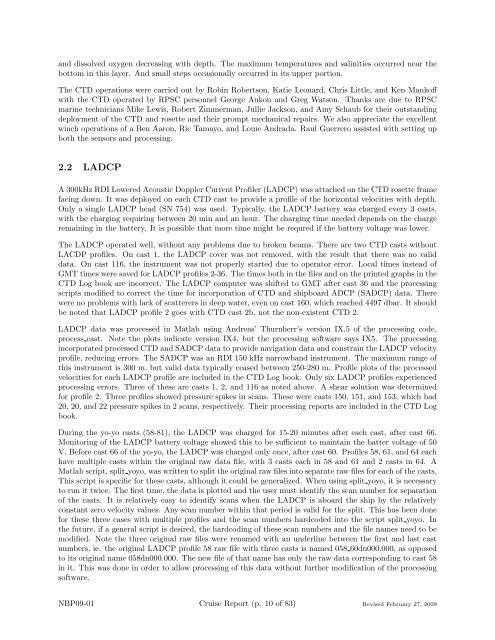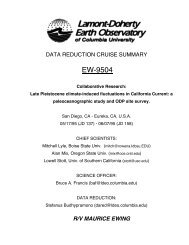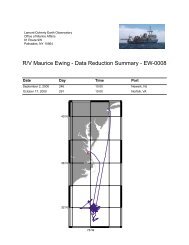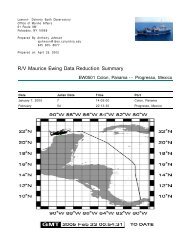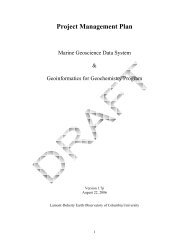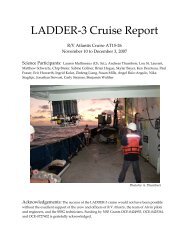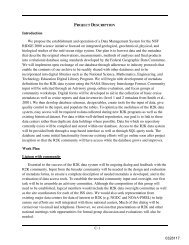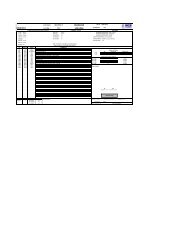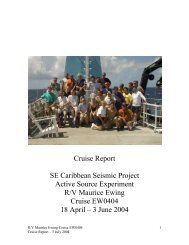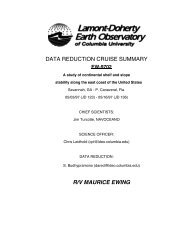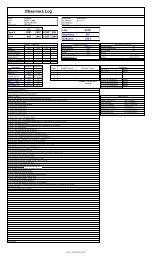and dissolved oxygen decreasing with depth. The maximum temperatures and salinities occurred near thebottom in this layer. And small steps occasionally occurred in its upper portion.The CTD operations were carried out by Robin Robertson, Katie Leonard, Chris Little, and Ken Mankoffwith the CTD operated by RPSC personnel George Aukon and Greg Watson. Thanks are due to RPSCmarine technicians Mike Lewis, Robert Zimmerman, Jullie Jackson, and Amy Schaub for their outstandingdeployment of the CTD and rosette and their prompt mechanical repairs. We also appreciate the excellentwinch operations of a Ben Aaron, Ric Tamayo, and Louie Andrada. Raul Guerrero assisted with setting upboth the sensors and processing.2.2 LADCPA 300kHz RDI Lowered Acoustic Doppler Current Profiler (LADCP) was attached on the CTD rosette framefacing down. It was deployed on each CTD cast to provide a profile of the horizontal velocities with depth.Only a single LADCP head (SN 754) was used. Typically, the LADCP battery was charged every 3 casts,with the charging requiring between 20 min and an hour. The charging time needed depends on the chargeremaining in the battery. It is possible that more time might be requred if the battery voltage was lower.The LADCP operated well, without any problems due to broken beams. There are two CTD casts withoutLACDP profiles. On cast 1, the LADCP cover was not removed, with the result that there was no validdata. On cast 116, the instrument was not properly started due to operator error. Local times instead ofGMT times were saved for LADCP profiles 2-36. The times both in the files and on the printed graphs in theCTD Log book are incorrect. The LADCP computer was shifted to GMT after cast 36 and the processingscripts modified to correct the time for incorporation of CTD and shipboard ADCP (SADCP) data. Therewere no problems with lack of scatterers in deep water, even on cast 160, which reached 4497 dbar. It shouldbe noted that LADCP profile 2 goes with CTD cast 2b, not the non-existent CTD 2.LADCP data was processed in Matlab using Andreas’ Thurnherr’s version IX.5 of the processing code,process cast. Note the plots indicate version IX4, but the processing software says IX5. The processingincorporated processed CTD and SADCP data to provide navigation data and constrain the LADCP velocityprofile, reducing errors. The SADCP was an RDI 150 kHz narrowband instrument. The maximum range ofthis instrument is 300 m, but valid data typically ceased between 250-280 m. Profile plots of the processedvelocities for each LADCP profile are included in the CTD Log book. Only six LADCP profiles experiencedprocessing errors. Three of these are casts 1, 2, and 116 as noted above. A shear solution was determinedfor profile 2. Three profiles showed pressure spikes in scans. These were casts 150, 151, and 153, which had20, 20, and 22 pressure spikes in 2 scans, respectively. Their processing reports are included in the CTD Logbook.During the yo-yo casts (58-81), the LADCP was charged for 15-20 minutes after each cast, after cast 66.Monitoring of the LADCP battery voltage showed this to be sufficient to maintain the batter voltage of 50V. Before cast 66 of the yo-yo, the LADCP was charged only once, after cast 60. Profiles 58, 61, and 64 eachhave multiple casts within the original raw data file, with 3 casts each in 58 and 61 and 2 casts in 64. AMatlab script, split yoyo, was written to split the original raw files into separate raw files for each of the casts.This script is specific for these casts, although it could be generalized. When using split yoyo, it is necessaryto run it twice. The first time, the data is plotted and the user must identify the scan number for separationof the casts. It is relatively easy to identify scans when the LADCP is aboard the ship by the relativelyconstant zero velocity values. Any scan number within that period is valid for the split. This has been donefor these three cases with multiple profiles and the scan numbers hardcoded into the script split yoyo. Inthe future, if a general script is desired, the hardcoding of these scan numbers and the file names need to bemodified. Note the three original raw files were renamed with an underline between the first and last castnumbers, ie. the original LADCP profile 58 raw file with three casts is named 058 60dn000.000, as opposedto its original name 058dn000.000. The new file of that name has only the raw data corresponding to cast 58in it. This was done in order to allow processing of this data without further modification of the processingsoftware.<strong>NBP09</strong>-<strong>01</strong> <strong>Cruise</strong> <strong>Report</strong> (p. 10 of 83) Revised February 27, 2009
In front of the Dotson Ice Shelf, the East-West velocity was aligned roughly along the front of the ice shelfcavity and the North-South velocity in/out of the cavity. For the corresponding LADCP profiles for CTDcast 119 (Figure 4), the North-South velocity (V, green line in Figure 5) was positive, indicating outflow fromthe cavity, from below the SML (50 m) to the bottom. The North-South velocity did fluctuate with depth,but did not indicate clear layers. However, the East-West velocities (U, red line) changed direction at around250 m, indicating two layers, as in the CTD structure. Below 400 m, corresponding to the lower layer of theCTD, U was relatively uniform at ∼8 cm/s and V uniform at ∼9 cm/s. The result was a northeasterly flowof the lower layer. This indicates exiting CDW after transit of the ice shelf cavity. The upper layer behavioris more complex. Between 100-160 m, roughly the depth of the large step or layer in CTD 119, the East-Westvelocity was constant at ∼7-8 cm/s and the V velocity ∼5-6 cm/s. This portion of the upper layer, depths100-160 m, appears to be flowing WNW roughly at a 30o with the front of the ice shelf. Below this layer,stronger U velocities occur in a 40 m layer from ∼160-200 m, which corresponds to two ∼20 m layers intemperature. At depths of 200-260 m, U velocities are small and change direction and V velocities weaken.Strong intrusions occur in this depth range of weaker velocities. The weaker velocities may enable water tointerleave more easily, increasing intrusions. It is likely the interleaving water masses originated from theice shelf cavity south of this site and a water mass north of this site, since the V velocities are stronger forthis depth range. In the transition layer, ∼300 to 400 m, U velocities generally increased in magnitude andV velocities fluctuated between 7 and 9 cm/s. A series of peaks at roughly 75 m intervals were apparent inthe V velocities between 100 and 300 m depth. There were no apparent correlations between this series ofvelocity peaks and the temperature or salinity profiles of the CTD.The LADCP operations were carried out by Robin Robertson, Katie Leonard, Chris Little, and Ken Mankoff.Raul Guerrero assisted with installation of the LADCP and battery charging.2.3 Dissolved OxygenKatherine Leonard, Chris Little, Ken MankoffTwo SBE 43 dissolved oxygen sensors are a standard part of the CTD sensor array. SBE 43 sensors havean accuracy of 2 percent of saturation, and a stability of 2 percent per 1000 hours. Titrated values bythe Winkler method are also necessary to ’calibrate’ the CTD oxygen sensors, i.e., to correct for sensorbias, drift and potential offsets. During <strong>NBP09</strong><strong>01</strong>, 407 oxygen samples were collected for Winkler titrationfrom 126 CTD stations, plus an electronically undocumented cast at the site of station two. The Langdonamperometric titrator was used to determine dissolved oxygen concentrations in whole bottle samples ofapproximately 140 mL of seawater collected from the CTD rosette. In addition to those 407 samples, atleast 30 blanks and 125 standards were also determined using the automated titrator system.Three liters of KIO 3 standard were prepared and shipped south by C. Langdon in September 2008, of which1.725 L were used in running standards and blanks during the course of the cruise. The titrations alsoconsumed close to one liter each of MnCl and NaOH-NaI solutions for pickling samples, 5-molar H 2 SO 4 , andNa-Thiosulfate titrant. Approximately 100mL of each of these chemicals remained at the end of the cruise,but dispensing that liquid into water samples would have required different equipment than was availablein the NBP’s Langdon titrator system. Adequate supplies were unavailable on board with which to preparenew pickling chemicals, and the titrant stocked in dry form on board the NBP is the pentahydrate ratherthan the preferred anhydrous variety.Fewer than half the projected number of seawater samples were collected and analysed for dissolved oxygencontent during <strong>NBP09</strong>-<strong>01</strong>, due to constraints imposed by an insufficient supply of pickling chemicals. However,through careful management, cautious sampling strategies, and analysts’ nimbleness in spill-avoidance,the available reagents were stretched to allow sample collection through the final station of the cruise. Thetitration work, principally conducted by C. Little, proceeded smoothly, with occasional unexceptional hiccoughsdue to ship motion bouncing the magnetic stir-bars and air bubbles in the Na-Thio in the microburette and titrant lines. Sampling (principally by Little and Mankoff, with help from Leonard and Robertsonduring the pm and am shifts respectively) immediately followed each cast, from the deepest niskins first,<strong>NBP09</strong>-<strong>01</strong> <strong>Cruise</strong> <strong>Report</strong> (p. 11 of 83) Revised February 27, 2009
- Page 3 and 4: List of Figures1 Regional map of CT
- Page 5 and 6: Universities and to Raytheon Polar
- Page 8 and 9: 1, 7, 104, and 159. At least one ad
- Page 12: Primary-Secondary O2 sensor differe
- Page 15 and 16: Run Test 1 2 3 4 5 6 7 8 9 10 11Stb
- Page 17 and 18: In order to estimate the accuracy o
- Page 19 and 20: ice-ocean boundary layer. To do thi
- Page 21 and 22: Figure 17: Using small boat for rec
- Page 23 and 24: Figure 19: Planned mission profiles
- Page 25 and 26: was under way (Figure 17). This met
- Page 27 and 28: # Starttime, pos,duration, km427428
- Page 29 and 30: S. Jacobs O-274-N Mooring Schematic
- Page 31 and 32: at the helm.The high iceberg produc
- Page 33 and 34: Seasonal sea ice changes in the Amu
- Page 35 and 36: in the Amundsen Sea - (1) the confi
- Page 37 and 38: An automated camera system provided
- Page 39 and 40: presence of ice layers and wicked b
- Page 41 and 42: enough number to be able to regiona
- Page 43 and 44: 6 Seafloor MappingFrank Nitsche, Ka
- Page 45 and 46: Due to the location of the transduc
- Page 47 and 48: Figure 29: Water column thickness (
- Page 49 and 50: Figure 31: A south-to-north cross s
- Page 51 and 52: phytoplankton from the upper 200m w
- Page 53 and 54: uptake (K m ) as well as the maximu
- Page 55 and 56: Elmer UV/VIS Lambda 18 spectrophoto
- Page 57 and 58: Figure 37: Section plot of dissolve
- Page 59 and 60: ligand ’TAC’ (2-(2-Thiazolylazo
- Page 61 and 62:
Both GA and PA, at times, resulted
- Page 63 and 64:
9 Other Sampling and Profiling9.1 O
- Page 65 and 66:
Figure 42: XBTs gridded as if they
- Page 67 and 68:
on them. A single hollow column is
- Page 69 and 70:
in ways that are accessible to a wi
- Page 71 and 72:
AppendicesACruise ParticipantsPerso
- Page 73 and 74:
BCTD Station TableNo. Date Time Lat
- Page 75 and 76:
continued from previous pageNo. Dat
- Page 77 and 78:
CPre-cruise Project PlansC.1 Amunds
- Page 79 and 80:
Figure 48: Missions, three each, pe
- Page 81 and 82:
C.4 Collaborative Research: Samplin


